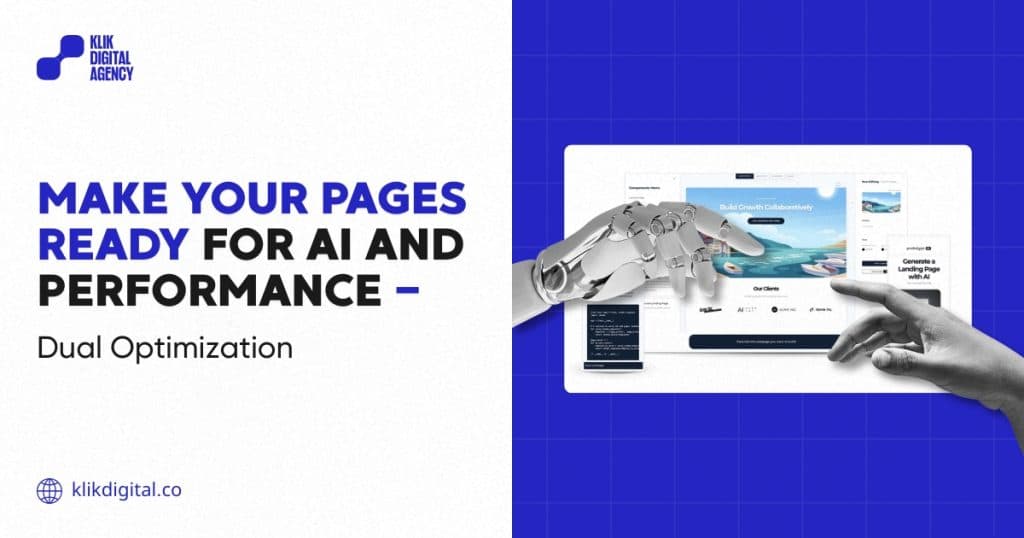Make Your Pages Ready for AI and Performance — Dual Optimization
Subscribe to our newsletter
Keep up with the latest news in the digital marketing arena with Klik Digital. Subscribe Now!
Error: Contact form not found.

The future of search is here, and it’s split into two demands: performance and AI visibility. It’s no longer enough to be fast OR smart. Your pages must be fast (for Core Web Vitals and users) AND smart (structured for Large Language Models). This seismic shift demands a Dual Optimization strategy. Neglect one side, and you risk losing visibility and conversions. At Klik Digital, we integrate these two priorities into a single, cohesive strategy to future-proof your website.
Why Dual Optimization Is the Future of Search
SEO is currently splitting into two distinct, yet interconnected, tracks: performance (the technical delivery of the page) and AI visibility (the machine’s comprehension of the content). This shift is driven by user behavior: 71% of Americans now use AI to search for information online.
The Rise of LLM-Driven Search (SGE, ChatGPT Search, Perplexity)
The introduction of generative AI into the search process has fundamentally changed how users consume information. Tools like Google’s Search Generative Experience (SGE), Perplexity, and integrated features within ChatGPT provide direct, summarized answers, often bypassing the need to click a traditional organic link.
This means:
- Direct Answer Extraction: AI engines scrape and synthesize information from multiple sources to create a “snapshot” answer (like Google’s AI Overviews).
- Citation is Key: Being included in that snapshot, even as a cited source, drives immense authority and traffic.
- Context Over Keywords: AI prioritizes content that provides deep, comprehensive, and structured context—not just pages stuffed with exact-match keywords.
Why AI Engines Prioritize Structure, Clarity, and Authority
AI models are sophisticated, but they still rely on clearly labeled data. If your site’s content is disorganized, ambiguous, or lacks authoritative sources, the LLM will ignore it in favor of clearer information. To be selected as a source by a generative engine, your content must demonstrate:
- Clarity: Definitions, examples, and data presented in easily digestible formats.
- Structure: Proper use of headings, lists, and semantic tags (Schema).
- Authority: Clear sourcing and deep topical expertise.

AI Optimization: Making Content Machine- Understandable
AI optimization (or Generative Engine Optimization) is the process of structuring your content so that it can be effortlessly read, understood, and cited by Large Language Models.
Role of Schema Markup, Structured Data, and Contextual Cues
Schema Markup is the Rosetta Stone of AI optimization. It provides context about your content (e.g., “This is a product review,” “This is an FAQ section,” “This is a local business”) directly to the machine.
- Actionable Data: Use specific Schema types like HowTo, FAQPage, Product, or Recipe to label key data points.
- Contextual Cues: Ensure your main topic is clearly introduced and defined early on.
Entity-Based Optimization and Topic Coverage
Instead of focusing on ranking for a single keyword, AI optimization focuses on owning the topic.
- Entity Linking: Clearly define key concepts (entities) on your page and link them to other authoritative internal or external sources.
- Semantic Completeness: Cover a topic exhaustively. If you discuss “AI optimization,” you should also include related subtopics like “LLM visibility” and “structured data” to show comprehensive expertise.
Semantic Completeness and LLM-Ready FAQs
LLMs excel at answering questions. Therefore, incorporating well-structured Q&A sections can greatly improve your chances of being cited in an AI search readiness summary. Ensure your answers are:
- Concise: Direct and brief, suitable for a snapshot answer.
- Authoritative: Backed by data or experience.
Importance of Definitions, Sources, and Data Structuring for AI Inclusion
AI needs verifiable, trustworthy information. Always include clear citations, links to original research, and a clear “About the Author” section to establish domain expertise and authority.
Performance Optimization: Making Content User-Friendly
While AI understands the content, performance optimization ensures that the user can actually access it quickly and easily—a factor Google has long stressed via Core Web Vitals (CWV).
How Core Web Vitals Influence Ranking and Engagement
Core Web Vitals are a set of metrics measuring real-world user experience. They remain a crucial ranking signal:
- LCP (Largest Contentful Paint): Measures loading performance. High LCP means slow load times—users bounce.
- CLS (Cumulative Layout Shift): Measures visual stability. High CLS means elements shift unexpectedly—users get frustrated.
- FID (First Input Delay): Measures interactivity. High FID means the page is slow to respond to clicks—users abandon the page.
Techniques: Lazy Loading, Image Compression, Caching, and Mobile Responsiveness
Achieving high CWV scores requires technical rigor:
- Image Compression and Next-Gen Formats: Use modern image formats (WebP) and compress them to reduce file size.
- Lazy Loading: Ensure images and media below the fold only load when the user scrolls down, significantly reducing initial page speed.
- Caching and CDN: Implement browser caching and use a Content Delivery Network (CDN) to serve content quickly from locations closer to the user.
- Mobile-First Design: A fast page is worthless if it’s broken on a phone. Ensure your site is perfectly responsive.
Reducing LCP, CLS, and FID for Faster User Experience
Prioritize fixing the factors that contribute most to these scores, often including eliminating render-blocking resources (CSS and JavaScript) and ensuring adequate server response time.

The Intersection: How AI and Performance Work Together
The two tracks of optimization are not separate; they are mutually reinforcing.
Google has explicitly stated that page speed is a factor in ranking. AI systems, which rely on efficient crawling and processing of web data, naturally gravitate toward sites that offer low latency and clear structure. A slow site increases the cost and time it takes for an LLM to scrape the data, making it less likely to be chosen as a primary source.
How Technical Optimization Supports AI Crawling and Comprehension
- Faster Crawling: Excellent page speed and clean code (performance optimization) allow search engine bots to crawl and index your site more frequently and deeply.
- Schema Accessibility: If your site is technically clean and fast, it ensures that Schema markup and other structured data are instantly recognized and processed by the AI’s data ingestion layer.
UX and Accessibility as Indirect AI Signals
Good User Experience (UX) and accessibility (e.g., proper use of ARIA tags, clean HTML) make your content logically structured. This logical structure—which helps a visually impaired person—also makes your content easier for an LLM to comprehend and synthesize.
Dual Optimization Framework by Klik
At Klik Digital, our Dual Optimization Framework is built to ensure every website we touch is ready for the GEO and LLMO future. Boost your brand’s online visibility across all search channels – from Google to ChatGPT, Perplexity to Claude.
Klik’s Approach: Combining SEO, Development, and Analytics
Our comprehensive approach combines proven SEO tactics with cutting-edge GEO and LLMO strategies to ensure you’re found wherever your customers search.
Step-by-step Methodology for Dual Optimization
- Technical Audit (Speed + Structure): We measure both Core Web Vitals (performance) and the integrity and completeness of all existing structured data (AI readiness).
- Semantic Mapping for AI Engines: We map your key topics against competitor LLM citations and AI-driven results to identify crucial topical gaps and missing entities.
- Data-Driven Prioritization: We prioritize fixes that provide the highest return on investment for both speed gains and semantic completeness.
- Performance and Schema Alignment: We implement fixes, ensuring that technical development work doesn’t break Schema integrity, and Schema implementation doesn’t slow down the page load.
Measuring Success in the Dual Optimization Era
Traditional ranking reports are no longer enough. Success must be measured through a blend of technical scores and generative visibility metrics.
Metrics beyond Rankings: LLM Visibility, AI Citations, Performance Scores
- LLM Visibility Score: Tracking how often your brand is cited or sourced in AI Overviews or other generative summaries.
- Performance Scores: Monitoring sustained increases in Core Web Vitals (LCP, CLS) and overall page speed grades.
- Engagement Metrics: Observing changes in time-on-page and bounce rate, as fast, clear content keeps users engaged longer.
- Traffic Quality: Analyzing traffic derived from AI sources vs. traditional organic search.

Tracking Changes in Impressions, Engagement, and Inclusion in AI Results
We focus on the conversion funnel. An increase in AI citations should lead to increased branded searches, better engagement, and, ultimately, higher conversions because your site is viewed as a definitive source.
The 2025 Roadmap for AI + Performance-Ready Websites
The future of search is here, and it’s fast, automated, and generative.
Future Trends: Adaptive Content Delivery, AI Agents as Search Intermediaries
We are moving toward an era of adaptive content delivery, where content dynamically adjusts based on the user’s intent and the AI agent serving them. Eventually, personal AI agents will become the primary search intermediaries, relying entirely on the structured, performance-optimized data they can instantly trust.
Preparing Now for an Ecosystem Where Visibility = Structure + Speed
To future-proof your website, you must stop viewing SEO as a single list of tactics. It is a dual discipline: ensuring your content is technically flawless for speed and semantically perfect for AI comprehension. Future-proof your website today — book an AI and performance audit with Klik Digital.
——————————————————————————————————-
FAQ

It means structuring your content using Schema markup and hierarchy so Large Language Models (LLMs) can easily understand, synthesize, and trust your information for generative answers.
The best way is to manually search on generative platforms (like SGE or Perplexity) to see if your site is cited as a source and to ensure all structured data passes validation tests.
Absolutely; Core Web Vitals remain a foundational ranking signal, and AI engines prioritize data from fast, stable websites because they are easier and cheaper for crawlers to process.
Dual optimization increases conversions by improving visibility in both search channels (AI and traditional) and boosting user experience, which reduces bounce rates and builds trust.








